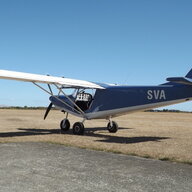Hi Kogg, nice looking machine.
When ICP altered their design by removing the slats and adding VGs, they also altered the profile of the leading edge of the wing. However, it's not clear what difference the change of wing profile made.
Your best source of information for your aircraft would be JG, who pioneered the slats-to-Vgs conversion on that model and conducted a great deal of testing. He flies the same aircraft as you, with slats removed and VGs added, and I don't think he changed his wing. His website is Stolspeed and is a goldmine of information. Suggest you contact him, see if he is open to a conversation:
https://www.stolspeed.com/
I'm a bit puzzled that you say 'im buffeting and beginning to stall power off with no flaps at 60 mph.' I fly a Savannah S, the POH gives a flaps up stall speed of 30 to 35 kts depending on loading, and I know it cruises quite happily at 45kts.
I note you are flying pretty much at Max All Up Weight and it could be interesting to know what your Weight and Balance is.




